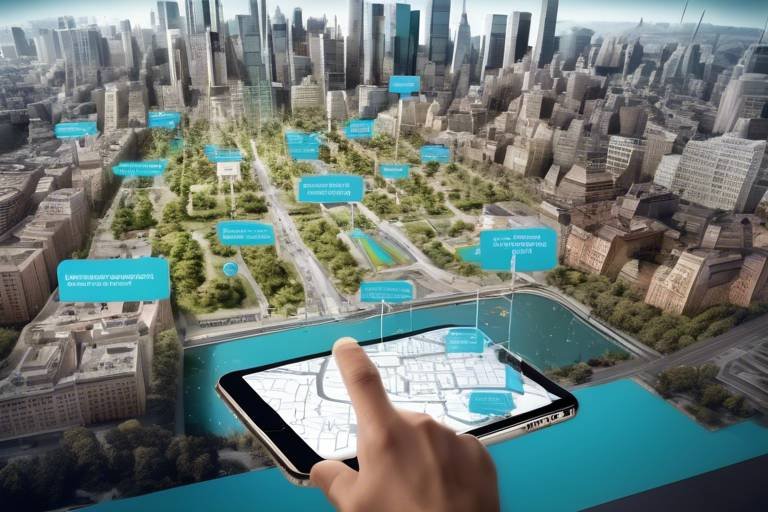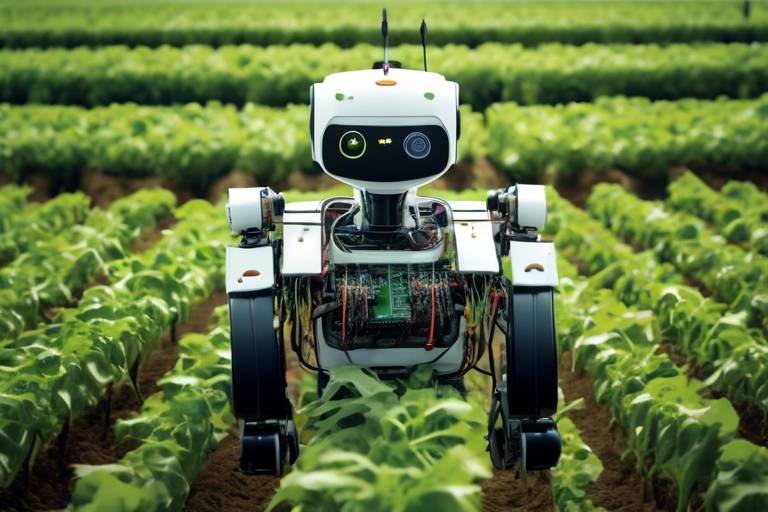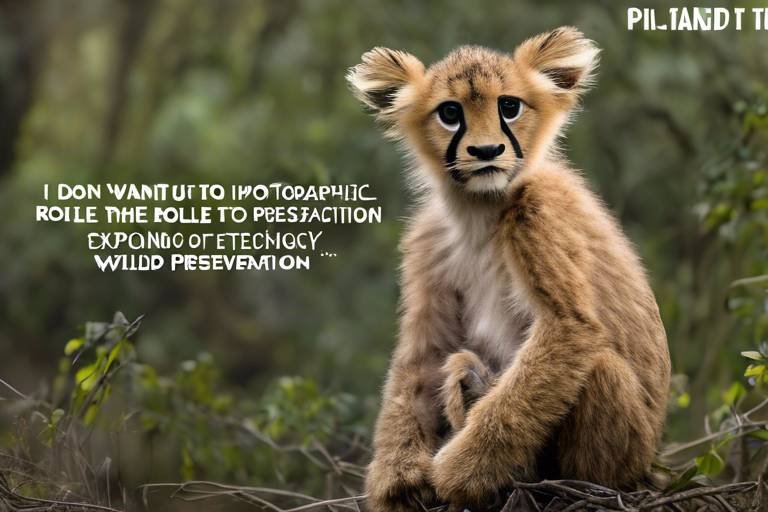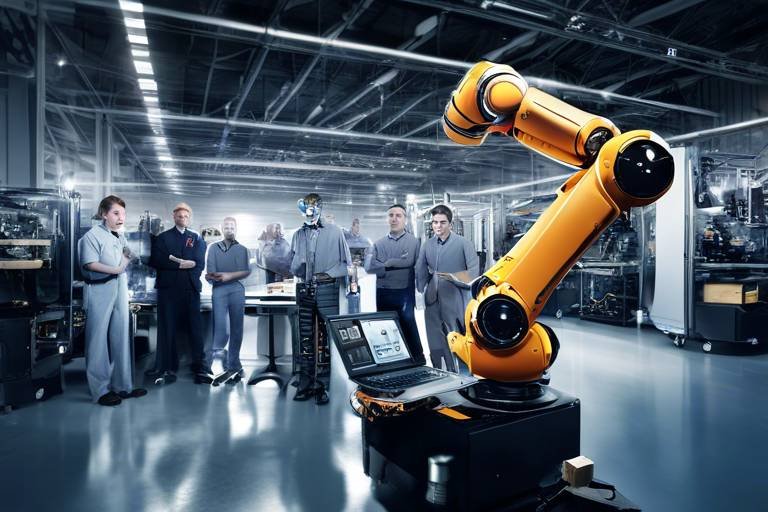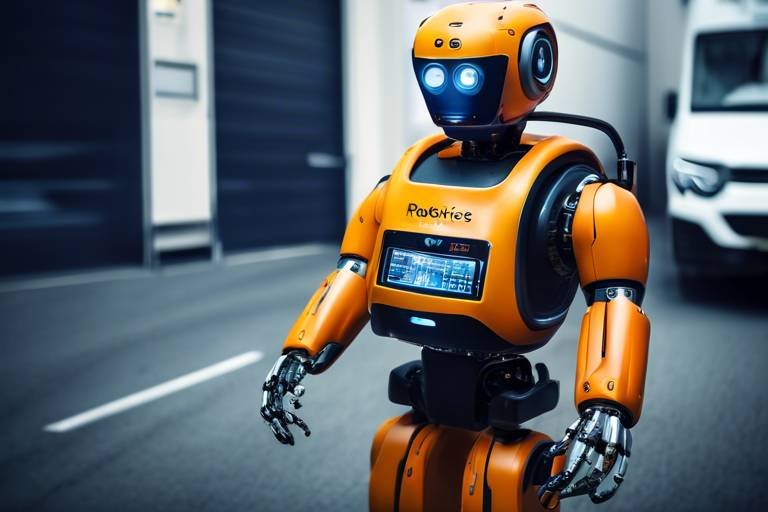The Role of Virtual Reality in Scientific Outreach
Imagine stepping into a world where the complexities of science become not just understandable but also exciting and engaging. Virtual reality (VR) is not just a tool for gaming or entertainment; it's a revolutionary medium that is reshaping how we communicate scientific knowledge. By immersing users in interactive environments, VR enhances engagement, improves accessibility, and fosters a deeper understanding of intricate scientific concepts among diverse audiences. This article will explore the multifaceted role of VR in scientific outreach, highlighting its potential to transform education and inspire curiosity.
One of the most significant advantages of virtual reality is its ability to create immersive experiences that captivate audiences. Unlike traditional teaching methods, which often rely on textbooks and lectures, VR allows users to interact with scientific content in a way that feels genuine and impactful. For instance, imagine exploring the depths of the ocean or walking on the surface of Mars—all from the comfort of your classroom or living room. This level of engagement not only makes learning fun but also leads to better retention and understanding of scientific principles. When learners can visualize and experience concepts firsthand, they are more likely to remember and apply that knowledge in real-life situations.
VR technology is breaking down barriers that have historically limited access to scientific education. It democratizes learning by making complex concepts accessible to a wider audience, including those who may not have access to traditional educational resources. For example, students in remote areas or underserved communities can now experience high-quality scientific education through VR programs without the need for expensive equipment or extensive infrastructure.
Virtual reality initiatives can specifically target underserved communities, offering them unique experiences that promote scientific literacy and inspire interest in STEM fields. This outreach is crucial for fostering diversity in science, as it opens doors for individuals who may have previously felt excluded from scientific discussions. By providing engaging and relatable content, VR can spark curiosity and motivate young minds to pursue careers in science and technology.
To maximize the impact of VR outreach efforts, partnering with local organizations is essential. These collaborations ensure that programs are tailored to community needs and interests, making the learning experience more relevant and effective. By pooling resources and expertise, organizations can create a more significant impact, reaching a broader audience and fostering a culture of curiosity and exploration.
Mobile VR solutions further enhance outreach programs by enabling them to reach remote or underserved areas. With the ability to provide educational experiences without the need for expensive equipment, mobile VR broadens the audience base and ensures that scientific knowledge is accessible to everyone, regardless of their location. This flexibility allows for spontaneous learning opportunities, empowering communities to engage with science on their terms.
Another exciting aspect of VR is its capacity to facilitate hands-on learning experiences that simulate real-world scientific processes. Imagine being able to conduct a virtual experiment in a lab or explore the human body in 3D. This active participation not only helps learners grasp complex concepts but also encourages curiosity and exploration in scientific fields. VR transforms passive learning into an adventure, making science feel alive and relevant.
Virtual reality serves as a dynamic platform for collaboration among scientists, educators, and the public. It enables shared experiences that promote dialogue and understanding of scientific research and its societal implications. By breaking down geographical barriers, VR fosters a global community of learners and researchers.
Hosting virtual conferences and workshops allows scientists to present their work in an engaging format, reaching global audiences and fostering collaboration across disciplines. This innovative approach makes scientific discussions more accessible, as participants can join from anywhere in the world, eliminating the need for travel and associated costs. Imagine attending a groundbreaking research presentation while sitting on your couch—it's the future of scientific communication!
Interactive VR models allow users to visualize and manipulate scientific data, enhancing comprehension and encouraging experimentation. This hands-on approach helps demystify complex topics and promotes a deeper understanding of scientific principles. By engaging with interactive models, learners can experiment with variables and see real-time results, making the learning process not just informative but also exhilarating.
- What is Virtual Reality? - Virtual reality is a simulated experience that can be similar to or completely different from the real world, often involving the use of VR headsets.
- How does VR enhance learning? - VR provides immersive experiences that engage users, making complex concepts easier to understand and remember.
- Can VR be used in remote areas? - Yes, mobile VR solutions can reach remote or underserved communities, providing access to scientific education without the need for extensive infrastructure.
- What are the benefits of VR in scientific outreach? - VR improves engagement, enhances accessibility, fosters collaboration, and encourages hands-on learning.

Enhancing Engagement through Immersive Experiences
This article explores how virtual reality (VR) is transforming scientific outreach by enhancing engagement, improving accessibility, and fostering a deeper understanding of complex scientific concepts among diverse audiences.
Imagine stepping into a world where you can explore the depths of the ocean or travel back in time to witness the formation of the universe—all from the comfort of your living room. Virtual reality (VR) makes this possible, creating immersive environments that captivate audiences like never before. With VR, traditional methods of presenting scientific content are thrown out the window. Instead of passively reading about scientific principles, users can actively engage with the material, making the learning experience not only more enjoyable but also more effective.
One of the most significant advantages of VR is its ability to foster better retention of information. When people are actively involved in their learning, they tend to remember what they’ve experienced far more than what they’ve merely read or listened to. This is especially crucial in scientific education, where complex concepts can often feel overwhelming. By allowing users to visualize and interact with these concepts, VR transforms abstract ideas into tangible experiences.
For instance, consider a VR simulation that allows students to conduct virtual experiments. Instead of just reading about chemical reactions in a textbook, they can mix virtual substances and observe the outcomes in real-time. This hands-on approach not only makes learning fun but also encourages curiosity and exploration, essential traits for any budding scientist. Furthermore, these immersive experiences can be tailored to fit various learning styles, ensuring that everyone—from visual learners to kinesthetic learners—can engage with the material effectively.
Additionally, VR can bridge the gap between complex scientific theories and everyday understanding. By presenting scientific concepts in a relatable and interactive manner, audiences can grasp ideas that previously seemed daunting. Whether it’s exploring the human body at a cellular level or understanding the vastness of space, VR breaks down barriers, making science accessible and engaging for all.
As we delve deeper into the world of VR, it’s essential to acknowledge the potential for collaboration among scientists, educators, and the public. By creating shared experiences, VR can promote dialogue about scientific research and its implications in our daily lives. This collaborative spirit is vital for fostering a community that values scientific inquiry and exploration.
In conclusion, the immersive experiences offered by virtual reality are revolutionizing the way we engage with science. By transforming passive learning into active participation, VR not only enhances understanding but also ignites a passion for discovery. The future of scientific outreach is here, and it’s more exciting than ever!
- What is virtual reality (VR)? VR is a technology that creates a simulated environment, allowing users to interact with 3D worlds using specialized equipment.
- How does VR enhance learning? VR enhances learning by providing immersive experiences that engage users, leading to better retention and understanding of complex concepts.
- Can VR reach underserved communities? Yes, VR can target underserved communities by offering unique educational experiences that promote scientific literacy.
- What are some examples of VR in scientific outreach? Examples include virtual labs, interactive scientific models, and immersive simulations that allow users to explore scientific principles hands-on.

Improving Accessibility to Scientific Knowledge
In today's fast-paced world, the dissemination of scientific knowledge is more important than ever. However, traditional methods of education often leave many individuals feeling disconnected from complex concepts. Virtual reality (VR) is stepping in to bridge this gap, transforming the way we access and understand scientific information. Imagine being able to explore the depths of the ocean or the vastness of space without ever leaving your home! VR makes this possible, offering a captivating way to learn that is not only engaging but also highly effective.
One of the biggest advantages of VR is its ability to democratize education. By utilizing this technology, we can reach a diverse audience that spans various demographics, including those who may not have access to traditional educational resources. For example, students in remote areas or economically disadvantaged backgrounds can now experience immersive learning environments that were previously out of reach. This accessibility is crucial for fostering a more inclusive scientific community.
Furthermore, VR can simplify complex topics that might otherwise seem daunting. Through interactive simulations, learners can visualize scientific processes in a way that text or lectures alone cannot achieve. Consider the following scenarios:
- A student struggling to grasp the concept of cellular biology can virtually walk through a cell, observing its components in action.
- An aspiring engineer can manipulate 3D models of bridges or machines, gaining hands-on experience that textbooks simply can't provide.
These immersive experiences not only enhance understanding but also spark curiosity and interest in scientific fields. As a result, individuals are more likely to pursue further education and careers in STEM (Science, Technology, Engineering, and Mathematics) disciplines. The potential for VR to improve accessibility is vast, and its impact on scientific literacy is profound.
Moreover, VR technology can be particularly effective in reaching underserved communities. By tailoring programs to meet the specific needs of these groups, we can create unique opportunities for learning and engagement. Collaborations with local organizations can further enhance these efforts, ensuring that VR initiatives resonate with the community's interests and values.
In conclusion, virtual reality is revolutionizing the way we access scientific knowledge. Through immersive experiences that engage and inspire, VR is not only making science more accessible but also enriching the educational landscape for everyone. As we continue to explore the possibilities of this technology, the future looks bright for scientific outreach and education.
- What is virtual reality (VR)? VR is a technology that creates a simulated environment, allowing users to interact with 3D spaces and objects as if they were real.
- How does VR improve accessibility to scientific knowledge? VR breaks down barriers by providing immersive educational experiences that can be accessed from anywhere, making complex concepts easier to understand.
- Can VR be used in classrooms? Absolutely! Many schools are incorporating VR into their curriculums to enhance learning and engagement.
- What are some examples of VR in scientific outreach? Examples include virtual field trips, interactive science exhibits, and simulations of scientific processes.

Reaching Underserved Communities
In today’s rapidly advancing world, virtual reality (VR) is emerging as a powerful tool for scientific outreach, especially in reaching underserved communities. These communities often face significant barriers to accessing quality education and scientific resources. By leveraging VR technology, we can break down these barriers and create inclusive learning environments that resonate with diverse audiences. Imagine a classroom where students from remote areas can explore the depths of the ocean or the vastness of space without ever leaving their hometowns. That’s the magic of VR!
One of the most compelling aspects of VR is its ability to provide unique experiential learning opportunities. For instance, students in underserved communities can engage in virtual field trips to museums, laboratories, or even outer space. This is particularly crucial because traditional educational resources may not be readily available to them. By immersing these students in captivating scientific environments, we can ignite their curiosity and inspire a passion for STEM (Science, Technology, Engineering, and Mathematics) fields.
Moreover, VR initiatives can be specifically designed to meet the needs of these communities. This means that the content can be tailored to reflect the local culture, challenges, and interests. For example, a VR program aimed at a community with a rich agricultural background could simulate sustainable farming practices or the science behind local ecosystems. This relevance not only makes learning more engaging but also empowers students to see the direct impact of science on their lives.
To maximize the impact of VR outreach, it’s essential to collaborate with local organizations. These partnerships can help ensure that the programs are well-received and effectively address the community’s unique challenges. Local organizations often have a better understanding of the specific needs and interests of the community, allowing for a more tailored approach. By pooling resources and expertise, we can create a more robust and effective outreach strategy.
Another exciting aspect is the use of mobile VR solutions. These portable setups allow outreach programs to reach remote or underserved areas without the need for expensive infrastructure. Imagine a community center equipped with mobile VR headsets, bringing the wonders of science right to the doorstep of eager learners. This flexibility not only broadens the audience base but also makes it easier to implement VR experiences in various settings, from schools to community events.
In conclusion, reaching underserved communities through virtual reality is more than just a technological advancement; it’s a transformative opportunity to foster scientific literacy and inspire the next generation of innovators. By creating engaging, relevant, and accessible VR experiences, we can empower these communities to explore the wonders of science and technology, paving the way for a brighter, more inclusive future.
- What is virtual reality (VR)?
Virtual reality is an immersive technology that allows users to experience and interact with a computer-generated environment, simulating real-world experiences. - How can VR help underserved communities?
VR can provide unique educational experiences, making scientific concepts more accessible and engaging for individuals who may lack traditional resources. - Are there any partnerships that enhance VR outreach?
Yes, collaborating with local organizations helps tailor programs to meet community needs and maximize impact. - What are mobile VR solutions?
Mobile VR solutions are portable setups that allow outreach programs to deliver VR experiences without needing extensive infrastructure.

Collaborations with Local Organizations
When it comes to making a real impact in scientific outreach, collaboration is key. Partnering with local organizations not only amplifies the reach of virtual reality (VR) initiatives but also ensures that these programs are tailored to meet the specific needs and interests of the community. Imagine a scenario where a local museum teams up with a university to create a VR experience that showcases the unique ecosystems found in their region. This kind of collaboration can lead to programs that are not only educational but also culturally relevant, making science feel more personal and relatable to participants.
Moreover, local organizations often have established trust within their communities. By leveraging this trust, VR outreach programs can attract more participants who might otherwise be hesitant to engage with scientific content. For example, a community center can serve as a hub for VR workshops, creating a safe space for learning and exploration. This approach fosters an environment where individuals feel comfortable asking questions and expressing their curiosity about scientific concepts.
In addition, collaborations can lead to the pooling of resources, allowing for the development of more robust and diverse educational experiences. Local organizations can provide access to venues, volunteers, and even funding opportunities that might be unavailable to standalone programs. This synergy can significantly enhance the quality and quantity of outreach efforts. As a result, scientists and educators can focus on what they do best—creating engaging and informative VR content—while local partners handle logistics and community outreach.
To illustrate the impact of such collaborations, consider the following table that highlights the potential benefits:
| Benefit | Description |
|---|---|
| Increased Reach | Local organizations can help tap into existing networks, reaching a broader audience. |
| Cultural Relevance | Programs can be tailored to reflect local interests and issues, making them more engaging. |
| Resource Sharing | Pooling resources can lead to more comprehensive and impactful educational experiences. |
| Trust Building | Collaborations leverage the trust local organizations have within their communities. |
In conclusion, collaborating with local organizations is a powerful strategy for enhancing the effectiveness of VR in scientific outreach. By working together, scientists, educators, and community leaders can create immersive experiences that not only educate but also inspire curiosity and a love for science among diverse audiences.
- What types of organizations can collaborate on VR outreach? Local schools, museums, community centers, and non-profits are excellent partners for VR initiatives.
- How can we ensure that VR content is culturally relevant? Engaging local experts and community members during the development phase can help tailor content to specific cultural contexts.
- What are the costs associated with implementing VR programs? Costs can vary widely, but partnerships can help minimize expenses through shared resources and funding opportunities.
- How do we measure the success of VR outreach programs? Success can be gauged through participant feedback, engagement levels, and knowledge retention assessments.

Utilizing Mobile VR Solutions
In today's fast-paced world, the ability to reach audiences with innovative educational tools is more crucial than ever. Mobile VR solutions have emerged as a game-changer in scientific outreach, enabling organizations to bring immersive experiences directly to communities, regardless of their location. Imagine being able to explore the depths of the ocean or the vastness of space without leaving your neighborhood! This accessibility is not just a dream; it’s becoming a reality thanks to the advancements in mobile VR technology.
One of the most significant advantages of mobile VR is its affordability and portability. Unlike traditional VR setups that often require expensive equipment and dedicated spaces, mobile VR can be experienced using smartphones and lightweight headsets. This means that educational institutions, community centers, and even local libraries can host VR experiences without breaking the bank. By leveraging existing technology that many people already own, mobile VR democratizes access to scientific education.
Moreover, mobile VR solutions can be tailored to fit the unique needs of various audiences. For instance, a program designed for elementary school students may focus on interactive experiences that introduce basic scientific principles, while a workshop for high school students might delve into more complex topics like genetics or astrophysics. This adaptability ensures that the content resonates with participants, making learning both fun and impactful.
To illustrate the potential of mobile VR in scientific outreach, consider the following table that highlights key benefits:
| Benefit | Description |
|---|---|
| Cost-Effective | Utilizes existing smartphone technology, reducing the need for expensive equipment. |
| Portability | Easy to transport, allowing outreach programs to reach various locations. |
| Customizable Content | Programs can be tailored to different age groups and educational levels. |
| Engaging Experiences | Immersive environments enhance learning and retention of scientific concepts. |
Additionally, mobile VR can bridge the gap between theory and practice. For example, students can virtually "visit" a laboratory or a research facility, observing experiments and processes that would be impossible to experience firsthand. This kind of engagement not only boosts understanding but also sparks curiosity and interest in STEM fields among young learners.
In conclusion, the utilization of mobile VR solutions represents a significant leap forward in making scientific knowledge accessible to all. By breaking down geographical and financial barriers, mobile VR fosters a more inclusive environment where everyone has the opportunity to explore, learn, and engage with science in a meaningful way. As we continue to embrace these technologies, the future of scientific outreach looks not only brighter but also more connected than ever before.
- What is mobile VR? Mobile VR refers to virtual reality experiences that can be accessed using smartphones and portable VR headsets, making it more accessible and affordable.
- How can mobile VR enhance scientific education? By providing immersive, interactive experiences, mobile VR helps students understand complex scientific concepts in a more engaging way.
- What are the benefits of using mobile VR in outreach programs? Mobile VR is cost-effective, portable, customizable, and offers engaging experiences that can reach diverse audiences.
- Can mobile VR be used in remote areas? Yes! Mobile VR is particularly effective in reaching underserved or remote communities, as it does not require extensive infrastructure.

Enhancing Hands-On Learning
Virtual reality (VR) is revolutionizing the way we approach hands-on learning in scientific education. Imagine stepping into a world where you can manipulate molecules, conduct experiments, or even explore the depths of the ocean—all from the comfort of your home or classroom. This immersive technology allows learners to engage with complex scientific processes in a way that traditional methods simply can’t match. By providing a realistic simulation of scientific phenomena, VR encourages a deeper understanding and appreciation of the subject matter.
One of the most exciting aspects of VR is its ability to create interactive environments where students can participate actively. Instead of passively listening to a lecture or reading from a textbook, learners can dive into simulations that challenge them to think critically and solve problems. For instance, a student studying biology might use VR to explore the intricate structures of cells, observing how they function in real-time. This type of engagement not only makes learning more enjoyable but also enhances retention, as students are more likely to remember information they have actively interacted with.
Moreover, VR can simulate scenarios that would be impossible or impractical to recreate in a traditional classroom setting. For example, learners can conduct virtual chemistry experiments without the risk of hazardous materials or the need for expensive lab equipment. This accessibility opens up opportunities for experiential learning that was previously limited to well-funded institutions. It democratizes education, allowing students from various backgrounds to gain valuable hands-on experience in scientific inquiry.
Additionally, VR fosters a sense of curiosity and exploration. When students are placed in an immersive environment, they are naturally inclined to experiment and discover. They can test hypotheses and see the immediate effects of their actions, which is a powerful learning tool. This hands-on approach not only demystifies complex topics but also instills a sense of confidence in learners, empowering them to pursue further studies in STEM fields.
To illustrate the impact of VR on hands-on learning, consider the following table that outlines the benefits of traditional learning versus VR-based learning:
| Aspect | Traditional Learning | VR-Based Learning |
|---|---|---|
| Engagement Level | Passive | Active |
| Accessibility | Limited resources | Widespread access |
| Realism of Experience | Abstract | Immersive and realistic |
| Safety | Risk of accidents | No physical risks |
In conclusion, virtual reality is not just a passing trend; it is a transformative tool that enhances hands-on learning in science education. By creating immersive, interactive experiences, VR captivates learners and allows them to explore scientific concepts in depth. As we continue to integrate this technology into educational settings, we can expect to see a generation of curious, knowledgeable, and empowered individuals ready to tackle the challenges of the future.
- What is virtual reality (VR)? VR is a technology that creates a simulated environment, allowing users to interact with 3D worlds using special devices like headsets.
- How does VR enhance learning? VR enhances learning by providing immersive experiences that engage students actively, making complex concepts easier to understand and remember.
- Is VR accessible for all students? Yes, VR can be tailored to reach diverse audiences, including those in underserved communities, by using mobile solutions and partnerships with local organizations.
- What subjects can benefit from VR? While VR is particularly effective in STEM fields, it can also enhance learning in areas like history, art, and social studies through immersive experiences.

Fostering Collaboration among Scientists
In today's fast-paced world, the importance of collaboration among scientists cannot be overstated. Virtual reality (VR) serves as a groundbreaking platform that not only facilitates communication but also enhances the collaborative process. Imagine a world where scientists from different corners of the globe can come together in a virtual environment, sharing insights and ideas as if they were in the same room. This is the power of VR, making scientific collaboration more accessible and engaging than ever before.
One of the most exciting aspects of VR is its ability to host virtual conferences and workshops. These events allow scientists to present their work in an immersive format, reaching a global audience without the usual constraints of travel and logistics. Participants can engage in real-time discussions, ask questions, and provide feedback, creating a dynamic learning environment. This not only broadens the reach of scientific knowledge but also encourages interdisciplinary collaboration, where experts from various fields can come together to tackle complex problems.
Moreover, VR technology enables the creation of interactive scientific models. These models allow users to visualize and manipulate data in a way that traditional methods simply cannot. For instance, imagine a biologist being able to explore a 3D model of a cell, zooming in on organelles and examining their functions in real-time. This hands-on approach demystifies complex topics and fosters a deeper understanding of scientific principles. By encouraging experimentation and exploration, VR helps to spark curiosity and innovation among scientists and students alike.
Additionally, the collaborative nature of VR can lead to the development of new scientific networks. By bringing together researchers, educators, and the public in shared virtual spaces, VR promotes dialogue around scientific research and its societal implications. This collaboration can lead to innovative solutions to pressing global challenges, from climate change to public health crises. With the ability to share resources and expertise, scientists can work together more effectively, breaking down traditional silos that often hinder progress.
As we look to the future, the role of VR in fostering collaboration among scientists is only expected to grow. The technology continues to evolve, offering new tools and opportunities for engagement. By embracing these advancements, the scientific community can enhance its outreach efforts, making science more inclusive and accessible to all.
- What is the role of VR in scientific collaboration? VR enhances communication and engagement among scientists by providing immersive environments for sharing ideas and research.
- How do virtual conferences work? Virtual conferences allow scientists to present their work and engage with a global audience in real-time, facilitating discussions and feedback.
- Can VR help in educating the public about science? Yes, VR can make complex scientific concepts more accessible and engaging, fostering public interest in STEM fields.
- What are interactive scientific models? These are 3D representations of scientific concepts that users can manipulate to better understand complex data.

Virtual Conferences and Workshops
In today's fast-paced digital world, have emerged as a groundbreaking way to disseminate scientific knowledge and foster collaboration among researchers, educators, and the public. Imagine being able to attend a cutting-edge symposium on climate change from the comfort of your living room, or participating in a hands-on workshop about the latest advancements in biotechnology without the hassle of travel. This is the magic of virtual events, and they are reshaping how we engage with science.
One of the most significant advantages of virtual conferences is their ability to reach a global audience. No longer confined to a specific location, scientists can present their work to attendees from all corners of the world. This democratization of knowledge not only enhances the visibility of research but also fosters collaboration across disciplines. For instance, a biologist in California can easily connect with a physicist in Germany, sparking innovative ideas that might not have occurred in a traditional setting.
Moreover, virtual workshops often incorporate interactive elements that keep participants engaged. Think about it: instead of passively listening to a lecture, attendees can participate in real-time discussions, ask questions, and even collaborate on projects using virtual tools. This level of interaction not only makes learning more enjoyable but also significantly enhances retention of information. A study showed that participants in interactive virtual workshops scored 30% higher on knowledge retention tests compared to those in traditional lectures.
Additionally, the flexibility of virtual events allows for a wider range of topics to be covered. Organizers can easily adapt sessions to include emerging trends or hot topics in science, ensuring that attendees are always up-to-date with the latest research. For example, a conference might feature a panel discussion on the implications of artificial intelligence in healthcare, followed by a workshop on ethical considerations in scientific research. This variety keeps the content fresh and relevant, appealing to a broader audience.
However, it’s essential to note that the success of virtual conferences and workshops hinges on effective technology and planning. Organizers must ensure that the platform used is user-friendly and capable of handling large numbers of participants without technical glitches. Furthermore, providing clear instructions and support for attendees can make a significant difference in their experience. A well-organized event can turn a skeptical participant into a lifelong advocate for scientific engagement.
In conclusion, virtual conferences and workshops are not just a temporary solution; they represent a fundamental shift in how we share and collaborate on scientific knowledge. By breaking down geographical barriers, enhancing interactivity, and adapting to current trends, these events are paving the way for a more inclusive and engaged scientific community. As we continue to navigate this digital age, the potential for virtual outreach in science is limitless.
- What are virtual conferences?
Virtual conferences are online events that allow participants to attend presentations, discussions, and workshops from anywhere in the world, using digital platforms.
- How do virtual workshops enhance learning?
Virtual workshops incorporate interactive elements, allowing participants to engage actively, ask questions, and collaborate, leading to better retention of knowledge.
- What technology is needed for virtual events?
Participants typically need a computer or mobile device with internet access, along with any necessary software or applications specified by the event organizers.
- Are virtual conferences as effective as in-person events?
Many studies suggest that virtual events can be equally effective, if not more so, due to their accessibility and the ability to include diverse perspectives from around the globe.

Creating Interactive Scientific Models
Imagine being able to step inside a cell, walk through its intricate structures, and witness the processes that keep life ticking. Interactive scientific models in virtual reality (VR) make this possible, transforming abstract concepts into tangible experiences. These models allow users to visualize complex data in a way that is not only engaging but also deeply educational. By manipulating these models, learners can experiment and explore scientific phenomena firsthand, leading to a more profound understanding of the subject matter.
One of the most exciting aspects of interactive models is their ability to simplify the complex. For instance, consider the structure of DNA. Through VR, students can not only see the double helix but can also rotate it, zoom in on specific sections, and even simulate genetic mutations. This hands-on approach demystifies topics that might otherwise seem daunting. The immersive nature of VR encourages active participation, which is crucial for learning. When learners are engaged, they are more likely to retain information and develop a genuine interest in scientific exploration.
Furthermore, these models can cater to various learning styles. Visual learners can benefit from the stunning graphics and animations, while kinesthetic learners can thrive through the interactivity offered by VR. This adaptability makes VR an invaluable tool in educational settings, particularly in science classes. By providing a platform where students can experiment without the constraints of a traditional classroom, VR fosters a deeper curiosity about the world around us.
To illustrate the impact of interactive scientific models, consider the following table that outlines some key benefits:
| Benefit | Description |
|---|---|
| Enhanced Understanding | Users grasp complex concepts more easily through visualization and manipulation. |
| Increased Engagement | Interactive experiences captivate users, making learning fun and memorable. |
| Accessibility | VR models can be accessed by anyone with a headset, breaking geographical barriers. |
| Encouragement of Exploration | Users are motivated to experiment and ask questions, fostering a scientific mindset. |
In addition to enhancing individual learning experiences, interactive scientific models also promote collaboration among peers. Students can work together in a virtual space, sharing insights and discoveries in real time. This collaborative aspect not only builds teamwork skills but also enriches the learning experience by exposing students to diverse perspectives and ideas.
In conclusion, the creation of interactive scientific models in virtual reality is revolutionizing the way we approach science education. By making complex concepts accessible and engaging, VR fosters a deeper understanding of scientific principles and inspires the next generation of scientists. As technology continues to evolve, the potential for these interactive experiences will only expand, paving the way for an exciting future in scientific outreach.
- What is virtual reality in the context of science education?
Virtual reality in science education refers to the use of immersive technology to create interactive environments where learners can engage with scientific concepts in a hands-on manner. - How do interactive scientific models enhance learning?
These models allow users to visualize and manipulate complex data, making it easier to understand and retain information. They also promote active participation and exploration. - Are interactive VR models accessible to everyone?
Yes, as long as individuals have access to VR headsets, they can engage with these models, helping to break down geographical and educational barriers. - Can VR be used for collaboration in scientific research?
Absolutely! VR facilitates collaboration among scientists and educators, allowing them to share insights and experiences in a virtual environment.
Frequently Asked Questions
- What is virtual reality (VR) and how is it used in scientific outreach?
Virtual reality (VR) is a technology that creates immersive, computer-generated environments where users can interact with 3D worlds. In scientific outreach, VR is used to engage audiences by allowing them to experience complex scientific concepts in a hands-on manner, making learning more interactive and enjoyable.
- How does VR enhance engagement in scientific learning?
VR enhances engagement by providing immersive experiences that captivate users' attention. Unlike traditional methods, VR allows individuals to explore and interact with scientific content, leading to better retention and a deeper understanding of the material. It's like stepping into a science experiment rather than just reading about it!
- Can VR make science more accessible to everyone?
Absolutely! VR breaks down barriers by making scientific knowledge accessible to a wider audience, including those who may lack access to traditional educational resources. It offers unique opportunities for individuals in underserved communities, promoting scientific literacy and interest in STEM fields.
- How do VR programs reach underserved communities?
VR initiatives can specifically target underserved communities through partnerships with local organizations. These collaborations ensure that the programs are tailored to the community's needs and interests, maximizing their impact and fostering diversity in science.
- What are mobile VR solutions and how do they help?
Mobile VR solutions are portable VR setups that can be easily transported to remote or underserved areas. They provide educational experiences without the need for expensive equipment or infrastructure, allowing outreach programs to reach a broader audience and make science accessible to more people.
- How does VR facilitate hands-on learning?
VR enables hands-on learning by allowing users to simulate real-world scientific processes in a virtual environment. This active participation helps learners grasp complex concepts and encourages curiosity, making science feel more approachable and exciting.
- In what ways does VR foster collaboration among scientists?
VR serves as a platform for collaboration by enabling scientists, educators, and the public to share experiences and engage in dialogue about scientific research. Virtual conferences and workshops can bring together diverse audiences, promoting understanding and collaboration across various disciplines.
- What are interactive scientific models in VR?
Interactive scientific models in VR allow users to visualize and manipulate scientific data in real-time. This hands-on approach enhances comprehension of complex topics and encourages experimentation, making it easier for learners to understand scientific principles.




